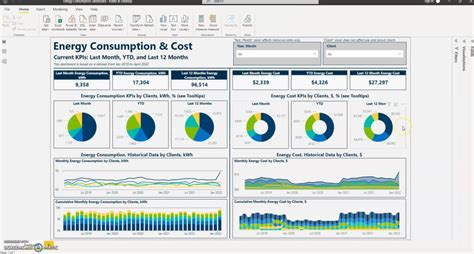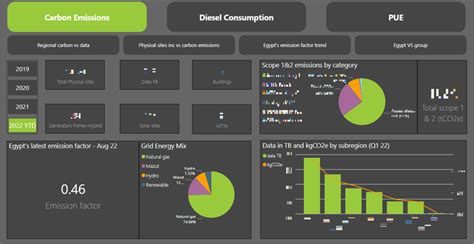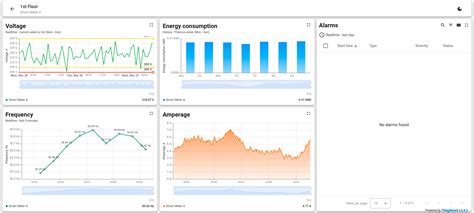As the world grapples with the challenges of climate change, energy efficiency, and sustainability, understanding energy consumption patterns has become increasingly crucial for individuals, businesses, and governments alike. Power BI, a leading business analytics service by Microsoft, offers a powerful platform for gaining insights into energy consumption through data analysis and visualization. By leveraging Power BI, organizations can make informed decisions to reduce their energy footprint, optimize energy usage, and contribute to a more sustainable future. In this article, we will delve into the world of Power BI energy consumption insights, exploring how this technology can be harnessed to analyze, visualize, and act upon energy-related data.
Key Points
- Power BI provides a robust platform for analyzing and visualizing energy consumption data, enabling organizations to identify areas of inefficiency and opportunities for improvement.
- Through the use of dashboards and reports, Power BI facilitates the creation of customized energy consumption insights tailored to the specific needs of various stakeholders.
- Integrating Power BI with IoT devices and other data sources can provide real-time energy consumption data, allowing for timely interventions and optimized energy management strategies.
- Advanced analytics capabilities in Power BI, such as predictive modeling and machine learning, can help forecast energy demand and identify potential bottlenecks in energy supply chains.
- By adopting Power BI for energy consumption insights, organizations can contribute to sustainability goals, reduce operational costs, and enhance their brand reputation through environmentally responsible practices.
Navigating Energy Consumption Data with Power BI

One of the primary challenges in managing energy consumption effectively is the complexity and volume of the data involved. Power BI addresses this challenge by offering a user-friendly interface for connecting to various data sources, such as energy meters, building management systems, and other IoT devices. Once the data is integrated into Power BI, users can leverage a wide range of visualization tools, including charts, maps, and tables, to transform the data into actionable insights. For instance, a utility company can use Power BI to analyze customer energy consumption patterns, identifying peak usage hours and devising targeted campaigns to promote energy efficiency during these periods.
Customized Dashboards for Stakeholder Engagement
A key feature of Power BI is its ability to create customized dashboards that cater to the specific needs and interests of different stakeholders. For energy consumption insights, this could mean designing a dashboard for facility managers to monitor real-time energy usage across different buildings or floors, or creating a report for executive teams to overview organizational energy performance and strategic initiatives. These tailored visualizations not only facilitate better decision-making but also foster a culture of transparency and accountability within the organization. Moreover, the interactive nature of Power BI dashboards allows users to drill down into specific data points, exploring the underlying factors contributing to energy consumption trends and patterns.
| Energy Consumption Metric | Actual Value | Target Value |
|---|---|---|
| Average Daily Energy Consumption (kWh) | 500 | 420 |
| Peak Hour Energy Demand (kW) | 200 | 180 |
| Energy Consumption per Square Foot (kWh/sqft) | 2.5 | 2.2 |

Advanced Analytics for Predictive Energy Management

Power BI’s advanced analytics capabilities, including predictive modeling and machine learning algorithms, offer a powerful toolset for predictive energy management. By analyzing historical energy consumption patterns, weather data, and other external factors, organizations can build models that forecast energy demand with a high degree of accuracy. This predictive capability enables proactive energy management strategies, such as adjusting energy-intensive operations to off-peak hours, optimizing energy storage solutions, and renegotiating energy contracts based on predicted demand. Furthermore, the integration of IoT sensors and real-time data feeds into Power BI can provide instantaneous insights into energy usage, allowing for immediate corrective actions to be taken in response to anomalies or inefficiencies.
Real-Time Monitoring and IoT Integration
The ability to integrate Power BI with IoT devices and other real-time data sources is a game-changer for energy consumption insights. By leveraging IoT sensors placed throughout facilities, organizations can capture granular data on energy usage, down to the level of individual devices or systems. This real-time monitoring capability allows for the identification of energy hogs, the detection of anomalies in energy consumption patterns, and the implementation of automated control strategies to optimize energy efficiency. For example, a manufacturing plant can use Power BI and IoT sensors to monitor the energy consumption of its production lines in real-time, making adjustments to reduce waste and improve productivity.
What are the primary benefits of using Power BI for energy consumption insights?
+The primary benefits include enhanced decision-making through data-driven insights, improved energy efficiency, reduced operational costs, and contributions to sustainability goals.
How can Power BI be integrated with IoT devices for real-time energy monitoring?
+Power BI can be integrated with IoT devices through various connectors and APIs, allowing for the direct ingestion of real-time data from sensors and devices into Power BI dashboards and reports.
What role can advanced analytics play in predictive energy management using Power BI?
+Advanced analytics, including predictive modeling and machine learning, can help forecast energy demand, anticipate supply chain disruptions, and inform strategic decisions about energy procurement and infrastructure investments.
In conclusion, Power BI offers a comprehensive and powerful platform for gaining insights into energy consumption patterns, analyzing data, and making informed decisions to reduce energy footprints. By harnessing the capabilities of Power BI, organizations can not only contribute to a more sustainable future but also reap the benefits of enhanced energy efficiency, reduced operational costs, and improved brand reputation. As the world continues to evolve towards more sustainable and environmentally conscious practices, the role of data analytics and visualization tools like Power BI will become increasingly critical in the pursuit of energy efficiency and sustainability.



